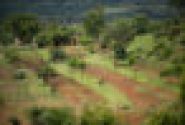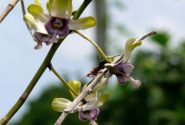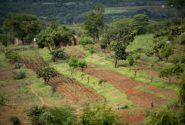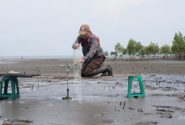
Aerial view of Lake Sentani, Papua, Indonesia. Mokhammad Edliadi/CIFOR
BOGOR, Indonesia (14 December, 2012)_Researchers working in northern Papua are helping to incorporate local community perceptions into development activities, using interviews, group discussions, mapmaking, and a workshop to encourage discussion between all stakeholders in the region.
“The prime objective of the project has been to provide input on land-use planning that is harmonious with the regional government’s planning, such as infrastructure development, but also that accommodates local priorities, and addresses sustainable development,” said Michael Padmanaba, a scientist with the Center for International Forestry Research (CIFOR) who has been working on the project.
The two-year-old government of Mamberamo Raya Regency in northern Papua (the first local election was held in 2010) has been looking at how it can manage its booming infrastructural development yet still provide health and education services to remote villages.
“We hope that this process enables the local government and the community to make decisions together,” added Manuel Boissière, a scientist with CIFOR and the Agricultural Research Center for International Development (CIRAD).
The project, run by helped facilitate a negotiation process between local people and the regional government.
Here they speak to Forests News about the two-year project, run by CIFOR, CIRAD and Conservation International Indonesia.
Q: What did your project set out to achieve?
Padmanaba: We wanted this project to demonstrate to the Mamberamo community and Mamberamo Raya Regency Government that useful information can be gathered for land-use planning by looking at the perceptions and priorities of the locals.
It is key to develop land-use plans, whose implementation can be monitored by both local government staff and villagers, and that reflect the aspirations of all stakeholders.
Mamberamo Raya is a new regency at just two year’s old, and it is still learning the ropes. When it was created, it developed a draft of the land-use plan based on the existing provincial-level plan. It hired a consultant to develop the plan, but it has not been accepted yet by the provincial government as it has not provided a complete picture of the territory. I’m not trying to say we proposed a better land-use plan, but we attempted to push the regency to look at land-use planning from another perspective.
We did this through introducing collaborative approaches such as conducting interviews, group discussions, participatory mapping and holding a workshop to bring villagers and officials to initiate discussions on land-use planning. The prime objective of these tools is to provide input on land-use planning that is harmonious with the regional government’s planning, such as infrastructure development, but also that accommodates local priorities, and addresses sustainable development.
Q: How did the regency respond to your input?
Padmanaba: During our final field trip to Mamberamo, which took place over 10 days in March this year, we recognised that our engagement with them was well accepted by the government. The Mamberamo Regent Bapak Demianus Kyew-kyew asked CIFOR, CIRAD and CI to continue working in Mamberamo. He said he was keen to engage in training government staff based on the training guidelines for collaborative land-use planning. Training will be carried out this year.
Q: What did your land-use planning guidelines consist of?
Padmanaba: Our land-use planning guidelines involved step-by-step methods such as interviews, focus groups discussions and participatory mapping, which can be implemented on the ground. During the workshop, we sat together with government and village representatives from the regency to discuss the future of the regency in terms of conservation and development. The six pilot villages, from a total of 59, were also happy with the program, especially the mapmaking component.
Q: Could you tell me more about why maps were a focus in this program?
Padmanaba Disseminating information through a report is commonly perceived as a dry method of communication and is sometimes hard to read. The visual nature of maps means people in the community can more easily understand the territory and quickly provide valuable information. Our participatory land use map was also developed on a scale of 1:50,000, which is similar to the scale required for official spatial planning and thus enables the government to use our maps.
Q: What challenges and sensitivities did you experience during the project?
Padmanaba: First, the area is hard to reach. For example, it can take three days by boat to reach some areas in Mamberamo. Second, we were only working with six pilot villages of a total 59, so we were only providing information relevant to villages representing several types of ecosystems.
There are also border issues between villages. The maps we developed had not been crosschecked with neighboring villages, especially concerning the borders, as our project only worked with six pilot villages chosen on factors such as market access and biodiversity. Therefore, a complete, approved picture still needs to be produced to avoid conflicts around border areas.
Boissière: The word “conservation” must also be used with caution when we are talking about land use. The people of Mamberamo often view this term as a way of taking away their right to their own land.
Q: What do you hope the community and the government can get out of the collaborative land-use planning methods?
Boissière: We showed the local government one way to develop a land-use plan and we have also proposed to train them. We expect that after training, it can continue and improve its engagement with the local communities, and that this approach to land-use planning can be applied throughout the remaining 53 villages.
We hope that this process enables the local government and the community to make decisions together. However, sometimes villagers might only look at decision-making with a short-term perspective. If a company plans to extract coal, for example, people sometimes see only the short-term benefit such as compensations. Our opinion is that we should let them know what the implications are, the risks and advantages, for them to take better-informed decisions.
We want you to share Forests News content, which is licensed under Creative Commons Attribution-NonCommercial-ShareAlike 4.0 International (CC BY-NC-SA 4.0). This means you are free to redistribute our material for non-commercial purposes. All we ask is that you give Forests News appropriate credit and link to the original Forests News content, indicate if changes were made, and distribute your contributions under the same Creative Commons license. You must notify Forests News if you repost, reprint or reuse our materials by contacting forestsnews@cifor-icraf.org.












